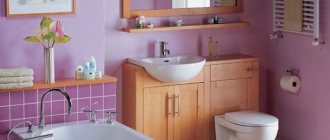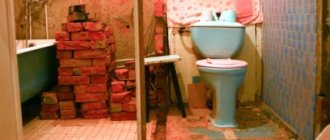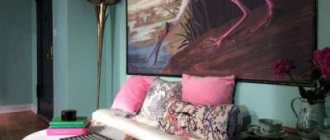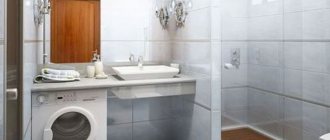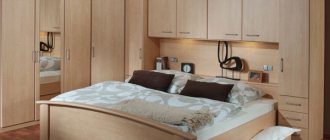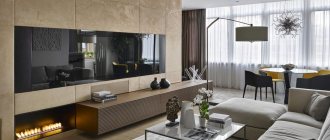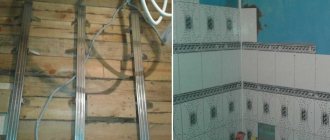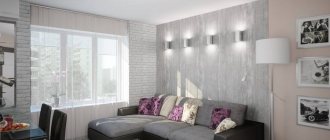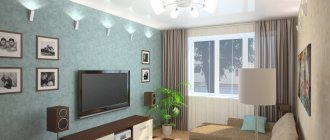The size of the bathroom in Khrushchev. The size of a standard bath in an apartment: in Khrushchev, in a panel house
To choose the right bathtub size for your bathroom, you need to consider several factors:
- the size of the bathroom (length, width, area), as well as the location of communications (hot and cold water supply, sewerage);
- proposed layout.
For both Khrushchev and panel houses, the planning factor is important: what exactly is planned to be placed in the bathroom?
Some people prefer the ascetic option, when there is only a bathroom, a washbasin, a laundry basket, and that’s it. A slightly more advanced option, when there is also a washing machine.
Finally, there are craftsmen who install a whole set of cabinets, cabinets in the bathroom and even manage to install a shower stall in addition to the bathtub.
Features of choosing a bath for Khrushchev
Khrushchev buildings were created as mass-produced and inexpensive apartments to quickly solve the housing problem, and this problem was solved. In order to save money, the apartments were tiny, the bathrooms in them were
- with a wall length of 1.7 meters.
In the first type of bathroom, it is best to install a bathtub 1.5 meters long and up to 0.8 meters wide, preferably narrower. If a person does not like to lie in the bathtub for a long time, shorter bathtubs are also suitable: 1.2, 1, 0.9 meters, which are called sitz baths.
It is advisable to take a closer look at sitz baths, as their comfort is very high: they have handles for comfortable sitting, and their use allows you to allocate space for a washing machine or furniture.
If you are not a fan of lying in the bathtub, then it is better to take a sitz bath. You can even combine a sitz bath and a shower stall.
In bathrooms with a wall length of 1.7 meters, in addition to the above, you can also install a bathtub 1.7 meters long.
Features of choosing a bath for panel houses
The bathroom for panel houses has an area of 6 to 8 square meters. meters, therefore it allows you to install baths 1.9 meters long, as well as a variety of Jacuzzis, which are placed diagonally in the room.
It should be borne in mind that installing a jacuzzi will make it impossible to install a shower stall, install cabinets, and sometimes even a washing machine, so something will have to be sacrificed.
Bath material
Since ancient times, bathtubs have been made of cast iron. They are durable and last for decades. They retain heat for a relatively long time, and the noise from the stream of water is not very audible. The main disadvantage is the large weight of such a bathtub and the fact that chips that can form from a blow with a hard object cannot be restored. Modern cast iron bathtubs are covered with high-quality smooth enamel. It doesn't darken or get dirty as quickly as the old ones. Powder enamel will protect the bathtub from corrosion.
Steel baths are easier to transport, but less durable. Their disadvantage is a rapid loss of water temperature, strong jet noise, and the same enamel chips. They are cheaper than cast iron and acrylic.
Acrylic bathtubs are beautiful to look at, warm, and silent. There are also bathtubs made of acrylic and polymer concrete. They are very beautiful, but expensive.
Design of a combined bathroom in Khrushchev. Bathroom layout
A standard Khrushchev-era bathroom occupies 3 square meters. m when combined with a toilet and 2 sq. m with separate.
Any renovation begins with removing the partition between the bathroom, thereby increasing the usable area of the room. It is advisable to leave a separate option only if there are small children in the apartment.
The issue of communications is always no less problematic. In standard bathrooms, very often they cannot be moved to another location, and laying additional pipes greatly increases the cost of renovation.
Thus, when planning a design, it is recommended to focus on the established communication terminals without changing their location.
With shower
If in a Khrushchev-era building you remove the wall between the toilet and the bathroom, you get a niche into which the shower fits. This type of bathroom layout is becoming increasingly popular. Here it is advisable to lay the walls and floor with tiles, and use tempered glass as a fence.
There is another option - a corner location of the shower stall.
It is possible to use either a finished structure or a pallet with fencing. But there will be less space inside the room than with the first method, and the toilet with sink will have to be located on the left and right sides.
Bathtub combined with toilet
In order not to waste useful space, it is recommended to combine a bathroom with a toilet in Khrushchev-era buildings. Instead of a shower stall, you can install a full bath. The standard layout provides for its presence in the allotted space of 175/75 cm.
The disadvantage is that there is no space left for a washing machine, which, however, can be easily solved by placing it under the sink. This option is convenient because there is no need to redesign the entire bathroom.
Communications
Usually the communications to which the bathtub in the Khrushchev is connected are in an unsightly condition. Although many residents have already replaced pipes and risers with plastic ones. If you are just going to do this, then this is an excellent reason to change the interior of the room.
Often, the plumbing fixtures you plan to install will not connect directly to existing services. In this case, you should not give up the plumbing fixtures you like. It is better to change the connection system by laying new pipes in the right place. Currently existing materials and technologies make it possible to do this without special material costs and physical effort.
Dimensions of a bathroom in a private house. Standard room dimensions
It is no secret that the further placement of the necessary components in it depends on the dimensions of the bathroom. If you choose the right size, you will not regret that you allocated too little space for the bathroom. Or, conversely, your bathroom takes up too many precious square meters from other, more necessary rooms, such as a living room or bedroom. In addition, you need to decide on the sizes in advance in order to:
- conveniently place all the necessary components (toilet, bathtub, sink);
- correctly distribute the necessary communications;
- think over the decoration of the room.
And you also need to know: all parameters, even the most minimal ones, have their own specific norms and standards (SNiP and GOST). They are provided by law for use in cases where specialized construction organizations erect residential apartment buildings or public buildings for various purposes. Here, developers are forced to comply with generally accepted rules so that later there will be no problems with the delivery of the property.
Therefore, before you start remodeling anything in an apartment that is located in an apartment building, you need to obtain a permit.
These rules apply to all rooms without exception, including the bathroom. And if you live in a cottage or private house, then you do not need to take permission.
However, let's return to the main issue of bathroom dimensions. In the apartment they have the following parameters:
- width – not less than 0.8 m;
- depth – not less than 1.2 m;
- the ceiling height should be 2.5 m.
The door from the bathroom should go out into the corridor. In the corridor, the height from floor to ceiling should not be less than 2.1 m.
The typical dimensions of bathrooms in apartment buildings are usually standard. In the USSR, the size of toilets was not too large. In the "Khrushchev" the area did not exceed 3.8 square meters. m. In modern apartments, bathrooms have become much larger, their sizes reach 6 square meters. m. And in luxury housing, the toilet can be more than 9 square meters. m. When planning a bathroom in new buildings, developers sometimes take into account the wishes of future owners regarding layout and dimensions. Ask your construction company about this opportunity.
In addition, bathrooms may have minimal dimensions. And such options occur quite often. For example, the size of some toilets may even be much smaller than required by regulations. For example, there are premises with an area of less than 2 square meters. m.
Often, developers create a combined bathroom, in which a toilet is installed along with the bathtub. When determining the dimensions of such a room, the installation of all necessary plumbing fixtures must be taken into account.
Asymmetrical baths
Modern manufacturers also produce asymmetrical cast iron bathtubs. They can be left-handed or right-handed. This significantly expands the installation possibilities of such products.
When purchasing a cast iron bathtub of any shape, you need to make sure that the enamel coating is intact and there are no cracks, chips or other defects.
Typically, asymmetrical bathtubs are the most beneficial for any bathroom. They have the shape of a petal, fan or cut drop.
A wide selection of bathtubs with a length of 135 cm and asymmetrical shapes allows you to choose the most convenient one. In some rooms you can install a larger one - 150 cm.
The optimal size of a combined bathroom in a private house. Dimensions of bathrooms
Examples of bathroom layouts
The area of the bathroom is taken into account not only during renovation work, but also when purchasing a new home. And to understand whether all the necessary household items will fit in it, it is worth assessing the dimensions of the room. So you define:
- how best to place plumbing fixtures;
- how to lay all the necessary communications;
- what finishing options to use during renovation.
Regulatory regulation of parameters
Before starting redevelopment, you must obtain permission from the BTI
The height, width and optimal area of the bathroom are directly related to the linear dimensions of the bathroom. They are regulated by a considerable list of regulations of the relevant authorities, such as GOST and SNiP. Therefore, before you begin implementing your design projects, you need to familiarize yourself with the regulatory framework in this area. If this nuance is neglected, the redevelopment of the litter will be considered illegal.
Important! Separately, it is worth noting the redevelopment in the apartments. Most often, the BTI does not give the go-ahead for the implementation of the plan if the wet area differs in configuration from the bathroom of the neighbors below. Indeed, in such a situation, the area of the bathroom may be above the living area, which is unacceptable according to the standards.
What are the minimum dimensions?
Example of a small bathroom
Tips and tricks for summer residents and gardeners on the portal, as well as tips and tricks on water supply and heating.
The minimum parameters of the bathroom do not allow you to fit all the necessary equipment into the room. Therefore, owners of compact bathrooms try to expand the premises, but the main thing here is not to violate the sanitary standards specified in SNiP.
Minimum parameters:
- The height of the bathroom must be at least 2.5 m;
- the depth of the room will be 1.2 m;
- The width of the bathroom should not be less than 0.8-0.9 m;
- The ceiling height in the corridor near the bathroom will be at least 2.1 m.
The last point should be taken into account by those people who want to additionally equip the mezzanine.
↑ Initial data and idea
The bathroom in my Khrushchev apartment is separate. The clear dimensions of the bathroom are 1520*1360 mm, but with certain manipulations they can be increased by 5-6 cm in each dimension, which I will discuss below.
The main idea of the new bathroom was to turn the bathtub 90 degrees and orient it along the far wall (opposite the front door). In my wife’s and my opinion, this position is more rational, although we understood that we would lose ten centimeters in length.
How many meters is a bathroom in a Khrushchev building? Choosing the size of the bathroom
A comfortable bathroom should not only contain all the necessary plumbing fixtures, but also be spacious enough for a comfortable visit.
According to SNiP standards:
- There should be 70-110cm of free space in front of the bathroom.
- On both sides of the toilet there is 25 cm of area, and in front of it - 60 cm.
- In front of the sink – 70cm.
There should be 70-75 cm of functional space in front of the bathroom
Based on this, you can calculate the optimal size of a bathroom for a city apartment. Typically, a sink and toilet in such a room are located along one wall, and a bathtub or shower stall is installed against the adjacent one. The optimal functional area next to the washing machine is 90 cm.
There should also be space in the restroom for a washing machine.
Therefore, 2x2-2.5x2.5m are the approximate optimal dimensions of a bathroom in a small private house (combined) and in a city apartment. A convenient area for a divided restroom would be:
- bathroom – 1.5x2 meters,
- toilet – 0.9x1.5 meters.
The numbers are approximate. In fact, it all depends on the dimensions of the apartment.
Optimal sizes of bathrooms in residential buildings and apartments. Photo of a comfortable room 6m2
Important: When drafting a house or remodeling an apartment, keep in mind that according to the standards, residential premises must account for at least 80% of the area. For the bathroom, kitchen, hallway and storage room, respectively, 20% remains.
Most cottages usually only have combined toilets, the area of which is about 5-9 sq. m.
Corner baths
Corner baths are often asymmetrical, that is, the sides forming a right angle are of different lengths. This makes it possible to slightly increase the workplace. After all, in addition to various plumbing fixtures and furniture, you need to take into account that there is a door on one of the walls.
A corner asymmetrical bathtub 120x90 cm will be quite convenient for the owners. There are bathtubs measuring 115x72 cm and 180x130 cm. But this is rather a large bathtub. It will not allow you to save the necessary centimeters.
Bathroom designs with dimensions. Design Features
If you design your bathroom renovation correctly, you will be able to relax and unwind in the future. After all, when you take a bath, you really want to plunge into an atmosphere of calm and comfort.
When designing bathrooms, you should take into account the wishes of not only women, but also men. Representatives of the stronger sex also like to spend a long time in this room to relax their body and soul. Therefore, all family members should participate in the creation of the project, so that everyone can express their wishes and preferences.
Key points in creating a bathroom project:
- Create lighting around mirrors and shower stalls. You can immediately buy mirrors with built-in lighting.
- The heated towel rail should be placed in such a way that when the door is opened, it is not behind it.
- Depending on the height of family members, you need to select the size of the sink.
- Tiles should be purchased with a margin of approximately 10 to 15 percent, since they usually need to be cut on the outer rows.
- The dimensions of ceramic tiles may differ from those written on the packaging. First, you should measure the tile so that in the future there will be no problem with its shortage.
- It is not recommended to use natural wood in the bathroom interior. But if you have wooden furniture, then the heating elements of heated floors should not be located directly under the furniture. Wooden interior elements can be installed at a level of 10 - 20 cm from the floor.
- The presence of an acrylic bathtub means arranging a frame for it, since the sides are quite fragile.
- In a small room, preference should be given to lamps that are not afraid of high humidity. The best solution would be a lamp with a closed socket.
- Porcelain tiles cannot be laid on the floor; this option will be very slippery. The most common tile for flooring is lappated.
Bathroom doors
Typically, a bathtub in a Khrushchev-era building is separated from the rest of the room by a curtain or doors. The following types exist:
- Curtain doors made of glass or polyester. Glass ones are beautiful and easy to clean, but expensive. Polyester doors are much cheaper.
- Plastic ones are cheaper than glass ones and can be of different colors. A white bathtub framed by such a door looks very elegant.
- Sectional, can consist of two to seven sections. Suitable for bathtubs of non-standard shapes.
For a corner bath it is better to take four-section doors, for asymmetrical ones - five-section doors (accordion). How much does a cast iron bath cost?
The size of a bathroom in a brick Khrushchev building. Preparatory work
I took about two weeks to prepare for the immediate start of work in the bathroom to decide on the design of the future bathroom: draw up the wiring of water supply and sewerage, ventilation, tile laying scheme, etc.
So, what is a bathroom like in a typical Khrushchev panel building? In fact, this is just a cabin that was cast somewhere at DSK and already assembled was installed in its place in the Khrushchev-era building during construction. The cabin walls have a scanty thickness of 3-5 cm and are made of reinforced gypsum concrete. The material is very weak and easily crumbles with a hammer drill or even a hammer. In the figure below, the walls of the “cabin” are shaded and, as we see, they are adjacent to two load-bearing walls of the Khrushchev building, in one of which (between the kitchen and the bathroom) there are ventilation shafts.
In renovation practice, the most common option is to demolish the Khrushchev-era partition between the toilet and the bathroom, which supposedly makes the bathroom more spacious and creates a lot of additional space. However, in my opinion, this is the most common misconception: no matter how much I tried to hypothetically design such a “spacious” combined bathroom in my Khrushchev-era apartment building, nothing worked out for me.
As I already said, the dimensions of the bathroom in my Khrushchev-era apartment are 1360*1520 mm. We had a 150 cm bathtub on the long side, which we decided to replace with a 140 cm one and put it on the short side. For this, from the existing dimensions, I was missing 4 cm, which I decided to obtain by demolishing the wall of the bathroom adjacent to the load-bearing wall of the Khrushchev building with ventilation shafts. This "plasterboard concrete" was broken with a regular mason's hammer in just three to four hours. The hardest thing was to take out almost two full bathtubs of construction waste. The reinforcing mesh is carefully cut with a grinder.
Unfortunately, I cannot demonstrate the old, pre-renovation look of the Khrushchev-era bathroom, but believe me, everything was very sad there.
I warn you that by demolishing the Khrushchev wall, you deprive the ceiling of one point of support. It is composed of the same gypsum concrete and is part of a solid “cabin”. It can also be dismantled, but I decided to simply strengthen the bathroom ceiling by supporting it with 40*50 mm timber and 10*100mm dowels - this is quite enough.
Two of the four walls in the Khrushchev-era bathroom turned out to be crooked, with a blockage of up to 3 cm, so I had to start leveling them.
After I renovated the kitchen and hallway in my Khrushchev-era apartment, I already had some plasterer skills, but in the bathroom I decided to use a different method of leveling the walls, which I really liked in the end. Holes are drilled in several rows in the wall, self-tapping screws are screwed into them, the heads of which are aligned and thus the reference points of a new, flat and strictly vertical plane are obtained (in the first photo below you can see the screws sticking out of the wall on the right). We prime the walls and wait 1.5-2 hours. Next, we take slabs of moisture-resistant plasterboard 1500*600 mm, which are ideally adjusted to the dimensions of our wall in Khrushchev (1520 mm) and “glued” to the wall using a special adhesive solution for plasterboard. Unlike plaster, the adhesive composition hardens faster (up to 20 minutes), so the slabs do not slip. The composition is applied in “buns” every 15-20 cm, on which the gypsum board slab is placed and tapped with a mallet or pressed with a rule so that the plane of the slab coincides with the plane of the previously exposed screw heads.
Installing a small bath
Once you have decided on the choice of shape, material and model, you need to prepare a place for the bath. The walls are leveled, tiles or other facing material are laid. Then the floor is leveled.
In some models, the bathtub is attached to the wall. The hole is made with a puncher. A special plinth protects the joint from leakage. Then the legs and the bath itself are installed.
Bathroom finishing
For the design of a combined bathroom in Khrushchev, the following are used: plastic, drywall, tiles, artificial stone, decorative plaster, moisture-resistant paint, wallpaper. There are many ways to combine materials.
Tiling
In addition to classic ceramic tiles, glass products are presented on the market, incl. mirrored
Before laying, the walls must be leveled with plaster or drywall. To create the intended design, they use decorative inserts, baseboards, different shades of tiles, different arrangement, and contrast.
Finishing with plastic panels
When renovating a combined bathroom in a Khrushchev building with plastic, you can create any color scheme. The panels can be easily installed horizontally, at an angle or vertically.
The material is resistant to moisture, lasts a long time, and is lightweight. It is mounted on flat walls without lathing using glue and self-tapping screws. They can be used to cover plasterboard surfaces, pipelines and sewers.
Plastic panels are also suitable for suspended ceilings. It is not difficult to make holes in them for any type of lamps. This material looks good together with ceramic tiles.
